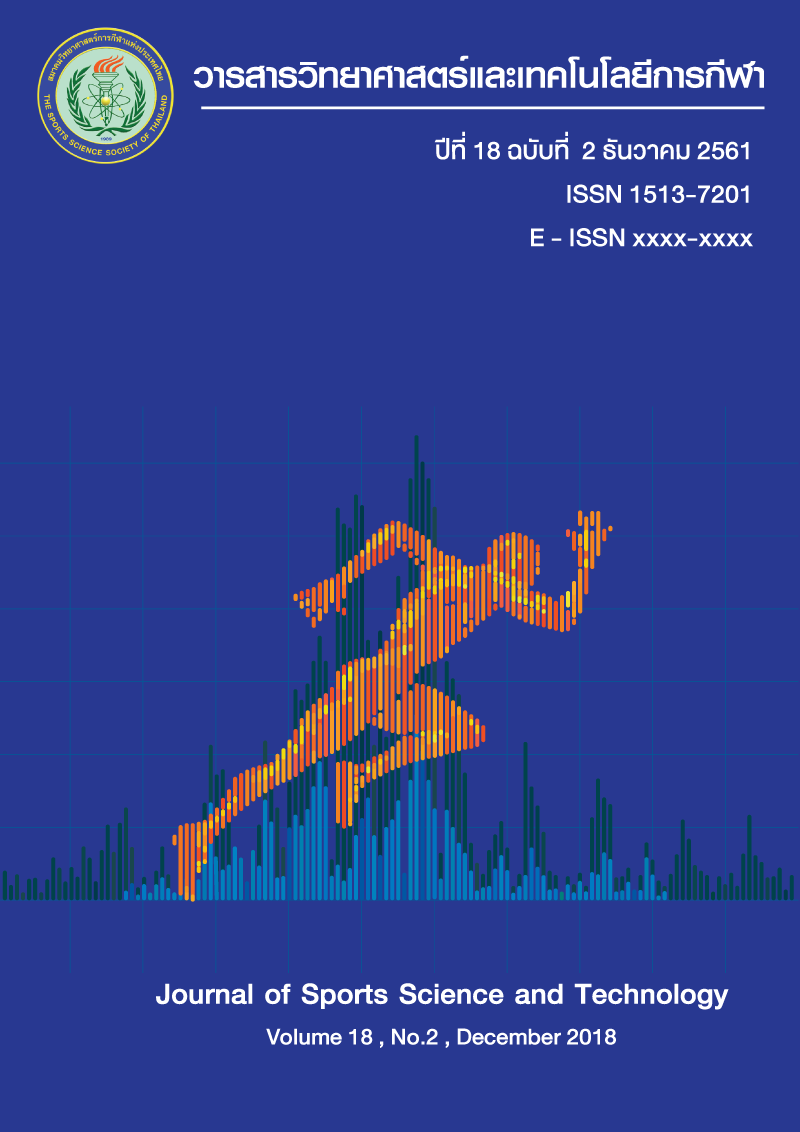THE EFFECTS OF COMBINED COMPRESSION BAND AND ACTIVE RECOVERY ON KNEE EXTENSOR MUSCLES AFTER EXERCISE-INDUCED MUSCLE SORENESS IN SEDENTARY HEALTHY MALE STUDENTS
Department of Physical Therapy, Faculty of Allied Health Science, Thammasat University, Pathum thani 12120
Keywords:
Recovery / Exercise-induced muscle soreness / Compression band / PlyometricAbstract
The purpose of this study was to determine the effects of compression band combined with active recovery on knee extensor muscles after exercise-induced muscle soreness in sedentary healthy male students.Twenty sedentary healthy male students aged between 18-25 years were randomly allocated to compression band combined with active recovery strategy (CA) (n=10) or active recovery strategy (AR) (n=10) for 30 minutes after completed 10 x 10 drop jumps from a 0.6-m box to induce muscle damage. Indirect indices of muscle damage (pain scale, muscle circumference and peak torque) were assessed before and after exercise-induced muscle soreness for 1, 24, 48, 72, and 96 hours respectively.The results showed that after exercise for one hour, both groups showed a statistically significant increase in pain scale (p < 0.05) and muscle circumference compared before the exercise (p < 0.05) but there was a statistically significant decrease in peak torque of knee extensor muscles compared before the exercise (p < 0.05). However, there were no statistically significant differences of time between groups throughout the recovery period. In Conclusion the application of combined compression band along with active recovery exercise had no significant effect on attenuating muscle soreness, reducing muscle circumference and modulating the decline in muscle peak torque of knee extensor muscles which were similar to that observed in active recovery alone.
(Journal of Sports Science and Technology 2018; 18(2): 61-72)
Key words: Recovery / Exercise-induced muscle soreness / Compression band / Plyometric
*Corresponding author: Thanawat KITSUKSAN Department of Physical Therapy, Faculty of Allied Health Science, Thammasat University, Pathum thani 12120 E-mail: Thanawat.k@allied.tu.ac.th
References
2. Cheung K, Hume P, Maxwell L. Delayed onset muscle soreness: treatment strategies and performance factors. Sports Med. 2003;33(2):145-64.
3. Connolly DA, Sayers SP, McHugh MP. Treatment and prevention of delayed onset muscle soreness. J Strength Cond Res. 2003;17(1):197-208.
4. Koizumi K, Fujita Y, Muramatsu S, Manabe M, Ito M, Nomura J. Active recovery effects on local oxygenation level during intensive cycling bouts. J Sports Sci. 2011;29(9):919-26.
5. Peake JM, Roberts LA, Figueiredo VC, Egner I, Krog S, Aas SN, et al. The effects of cold water immersion and active recovery on inflammation and cell stress responses in human skeletal muscle after resistance exercise. J Physiol. 2017;595(3):695-711.
6. Farias Junior LF, Browne RAV, Frazao DT, Dantas TCB, Silva PHM, Freitas RPA, et al. Effect of low-volume high-intensity interval exercise and continuous exercise on delayed-onset muscle soreness in untrained healthy males. J Strength Cond Res. 2017.
7. Mika A, Oleksy L, Kielnar R, Wodka-Natkaniec E, Twardowska M, Kaminski K, et al. Comparison of Two Different Modes of Active Recovery on Muscles Performance after Fatiguing Exercise in Mountain Canoeist and Football Players. PLoS One. 2016;11(10):e0164216.
8. Kraemer WJ, French DN, Spiering BA. Compression in the treatment of acute muscle injuries in sport: review article. Int J Sport Med. 2004;5(3):200-8.
9. O'Donnell TF, Jr., Rosenthal DA, Callow AD, Ledig BL. Effect of elastic compression on venous hemodynamics in postphlebitic limbs. JAMA. 1979;242(25):2766-8.
10. Goto K, Morishima T. Compression garment promotes muscular strength recovery after resistance exercise. Med Sci Sports Exerc. 2014;46(12):2265-70.
11. Gill ND, Beaven CM, Cook C. Effectiveness of post-match recovery strategies in rugby players. Br J Sports Med. 2006;40(3):260-3.
12. Driller MW, Overmayer RG. The effects of tissue flossing on ankle range of motion and jump performance. Phys Ther Sport. 2017;25(Supplement C):20-4.
13. Reeves GV, Kraemer RR, Hollander DB, Clavier J, Thomas C, Francois M, et al. Comparison of hormone responses following light resistance exercise with partial vascular occlusion and moderately difficult resistance exercise without occlusion. J Appl Physiol. 2006;101(6):1616-22.
14. Natsis K, Lyrtzis C, Noussios G, Papathanasiou E, Anastasopoulos N, Totlis T. Bilateral rectus femoris intramuscular haematoma following simultaneous quadriceps strain in an athlete: a case report. J Med Case Rep. 2010;4:56.
15. Marginson V, Rowlands AV, Gleeson NP, Eston RG. Comparison of the symptoms of exercise-induced muscle damage after an initial and repeated bout of plyometric exercise in men and boys. J Appl Physiol. 2005;99(3):1174-81.
16. Page W, Swan R, Patterson SD. The effect of intermittent lower limb occlusion on recovery following exercise-induced muscle damage: A randomized controlled trial. J Sci Med Sport. 2017;20(8):729-33.
17. Perrin DH. Isokinetic exercise and assessment. Champaign (IL): Human Kinetics Publishers; 1993.






